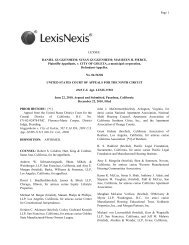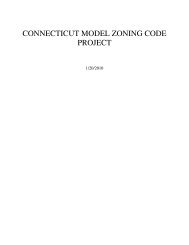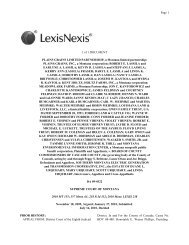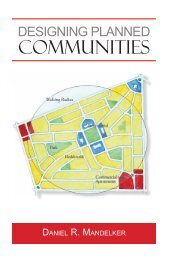Through a Glass Darkly: Measuring Loss Under ... - Land Use Law
Through a Glass Darkly: Measuring Loss Under ... - Land Use Law
Through a Glass Darkly: Measuring Loss Under ... - Land Use Law
You also want an ePaper? Increase the reach of your titles
YUMPU automatically turns print PDFs into web optimized ePapers that Google loves.
MEASURING LOSS UNDER MEASURE 37 601<br />
The continued enforcement of land use regulations can have both a<br />
positive impact and negative impact on property prices. For instance, the<br />
beneficial externalities of a land use restriction which both preserves trees,<br />
and encourages tree growth, may not be instantly observable. Indeed, tree<br />
canopy within a quarter mile of a property is estimated to represent between<br />
2.77% and 7.41% of the mean sale price for properties within the city of<br />
Portland, Multnomah County. 128 Conversely, it is far from inconceivable<br />
that a regulation could have a more onerous effect on property prices than<br />
reflected in the facial devaluation. Jaeger gives the example of “a municipality<br />
zon[ing] more land for commercial or industrial use than the demand<br />
would support, [where the eventual impact would be that] the prices for<br />
these lands would decline.” 129 The Sercombe methodology, in effect,<br />
freezes the loss at the point of enactment, and in doing so fails to take into<br />
consideration such longer term effects of the regulation. The following<br />
diagram illustrates how on Sercombe’s analysis the differential, and thus<br />
the compensation, is frozen at the facial effect of the regulation. 130<br />
Diagram 7<br />
Value of land prior to regulation<br />
Facial effect of<br />
regulation<br />
Rise in<br />
property<br />
market<br />
Fall in<br />
property<br />
market<br />
Effect/Cost<br />
of regulation<br />
equivalent to<br />
facial effect<br />
Counterfactual<br />
value (on<br />
Sercombe’s<br />
analysis)<br />
Actual Value<br />
(with regulation)<br />
Date of enactment<br />
Time<br />
128. Netusil, supra note 74.<br />
129. Jaeger, supra note 68, at 16.<br />
130. Sercombe’s method assumes that the only effect that the land use regulation<br />
will have on the value of the affected land is a facial effect. Therefore the differential<br />
between the “Counterfactual” and the actual value of the land (with the regulation in<br />
force) is frozen at that point. It fails to take into account the ongoing effects that the land<br />
use regulation will have on property values (e.g., particularly through amenity or<br />
“neighborhood” values). Sercombe, supra note 122.<br />
The rate of return multiplier Sercombe uses in his formula does not affect this analysis.<br />
As further developed in the body of this article, the rate of return multiplier merely<br />
compensates the owner for the loss of revenue potential to the extent of the facial devaluation<br />
(e.g., if the facial devaluation were $50, the rate of return multiplier would provide<br />
a return, say equivalent to the interest rate, on that amount) but it does not affect<br />
the differential between the counterfactual and actual values of the land itself. Id.<br />
ABA-TUL-07-0701-Sullivan.indd 601<br />
9/18/07 10:43:44 AM







